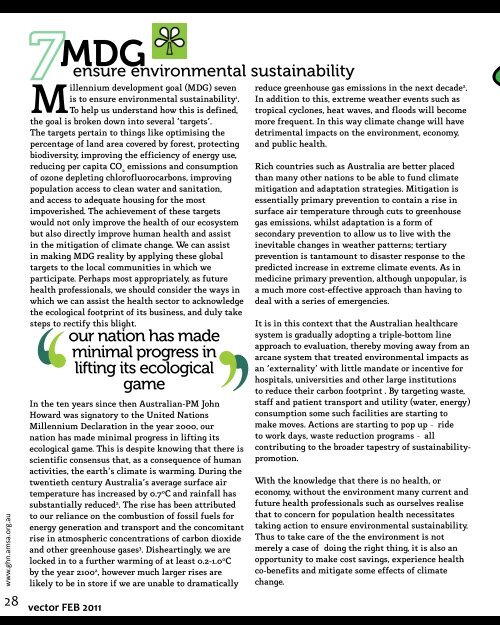Create successful ePaper yourself
Turn your PDF publications into a flip-book with our unique Google optimized e-Paper software.
www.ghn.amsa.org.au<br />
28<br />
7 MDG<br />
Millennium development goal (MDG) seven<br />
is to ensure environmental sustainability 1 .<br />
To help us understand how this is defined,<br />
the goal is broken down into several ‘targets’.<br />
The targets pertain to things like optimising the<br />
percentage of land area covered by forest, protecting<br />
biodiversity, improving the efficiency of energy use,<br />
reducing per capita CO 2<br />
emissions and consumption<br />
of ozone depleting chlorofluorocarbons, improving<br />
population access to clean water and sanitation,<br />
and access to adequate housing for the most<br />
impoverished. The achievement of these targets<br />
would not only improve the health of our ecosystem<br />
but also directly improve human health and assist<br />
ensure environmental sustainability<br />
in the mitigation of climate change. We can assist<br />
in making MDG reality by applying these global<br />
targets to the local communities in which we<br />
participate. Perhaps most appropriately, as future<br />
health professionals, we should consider the ways in<br />
which we can assist the health sector to acknowledge<br />
the ecological footprint of its business, and duly take<br />
steps to rectify this blight.<br />
‘‘<br />
‘‘<br />
scientific consensus that, as a consequence of human<br />
vector FEB <strong>2011</strong><br />
our nation has made<br />
minimal progress in<br />
lifting its ecological<br />
game<br />
In the ten years since then Australian-PM John<br />
Howard was signatory to the United Nations<br />
Millennium Declaration in the year 2000, our<br />
nation has made minimal progress in lifting its<br />
ecological game. This is despite knowing that there is<br />
activities, the earth’s climate is warming. During the<br />
twentieth century Australia’s average surface air<br />
temperature has increased by 0.7 0 C and rainfall has<br />
substantially reduced 2 . The rise has been attributed<br />
to our reliance on the combustion of fossil fuels for<br />
energy generation and transport and the concomitant<br />
rise in atmospheric concentrations of carbon dioxide<br />
and other greenhouse gases 3 . Disheartingly, we are<br />
locked in to a further warming of at least 0.2-1.0 0 C<br />
by the year 2100 2 , however much larger rises are<br />
likely to be in store if we are unable to dramatically<br />
reduce greenhouse gas emissions in the next decade 2 .<br />
In addition to this, extreme weather events such as<br />
tropical cyclones, heat waves, and floods will become<br />
more frequent. In this way climate change will have<br />
detrimental impacts on the environment, economy,<br />
and public health.<br />
Rich countries such as Australia are better placed<br />
than many other nations to be able to fund climate<br />
mitigation and adaptation strategies. Mitigation is<br />
essentially primary prevention to contain a rise in<br />
surface air temperature through cuts to greenhouse<br />
gas emissions, whilst adaptation is a form of<br />
secondary prevention to allow us to live with the<br />
inevitable changes in weather patterns; tertiary<br />
prevention is tantamount to disaster response to the<br />
predicted increase in extreme climate events. As in<br />
medicine primary prevention, although unpopular, is<br />
a much more cost-effective approach than having to<br />
deal with a series of emergencies.<br />
It is in this context that the Australian healthcare<br />
system is gradually adopting a triple-bottom line<br />
approach to evaluation, thereby moving away from an<br />
arcane system that treated environmental impacts as<br />
an ‘externality’ with little mandate or incentive for<br />
hospitals, universities and other large institutions<br />
to reduce their carbon footprint . By targeting waste,<br />
staff and patient transport and utility (water, energy)<br />
consumption some such facilities are starting to<br />
make moves. Actions are starting to pop up - ride<br />
to work days, waste reduction programs - all<br />
contributing to the broader tapestry of sustainabilitypromotion.<br />
With the knowledge that there is no health, or<br />
economy, without the environment many current and<br />
future health professionals such as ourselves realise<br />
that to concern for population health necessitates<br />
taking action to ensure environmental sustainability.<br />
Thus to take care of the the environment is not<br />
merely a case of “doing the right thing, it is also an<br />
opportunity to make cost savings, experience health<br />
co-benefits and mitigate some effects of climate<br />
change.

















